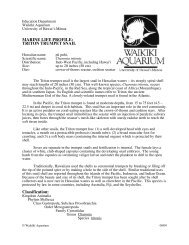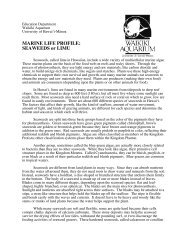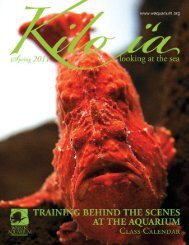Create successful ePaper yourself
Turn your PDF publications into a flip-book with our unique Google optimized e-Paper software.
esearch NEWS<br />
>> INVASIVE MANGROVES<br />
Mangroves were introduced to Moloka‘i in 1902 in an effort to stabilize<br />
coastal areas for growing sugar. Since then, the water-borne seeds of the<br />
coastal plant have spread throughout the main Hawaiian islands where<br />
the plant has taken hold, choking bays and eroding fishpond walls.<br />
In their natural environments, mangroves house rich and vital ecosystems.<br />
As an invasive species, however, they can wreak havoc on the<br />
existing endemic ecosystem. Dr. Andrew Sweetman, a post-doctoral scientist<br />
in the University of Hawaiçi’s biological oceanography department,<br />
has set out to unravel what effect mangroves are having on Hawai‘i’s<br />
coastal environments.<br />
Funded by the UH Sea Grant program, it’s part of a larger project<br />
looking at various anthropogenic stresses on Hawai‘i’s coastlines. The<br />
next phase will investigate what happens to sediments beneath openocean<br />
aquaculture cages.<br />
on BOARD<br />
Name:<br />
Charles R. Kelley M.D.<br />
Kilo iça<br />
Joined FOWA board:<br />
November 2004<br />
Can also be found at:<br />
the family hotel business<br />
where he is vice president of<br />
KF Development, Outrigger<br />
Enterprises, Inc. and president<br />
of Outrigger International<br />
Travel<br />
Favorite <strong>Aquarium</strong><br />
resident: The ulua<br />
“These issues resonate not just for Hawai‘i but for the world,” Sweetman<br />
says. “Invasive species are becoming a problem everywhere and will<br />
continue to do so with increased trade and, more importantly, climate<br />
change. I tend to look at these problems we’re facing as a father first and<br />
foremost. This situation is most likely only going to become worse, and<br />
our kids are going to be the ones that have to live and deal with it. This<br />
is why we’re trying to figure out the effects of these impacts now. Only<br />
by knowing these, can we start to propose sound coastal management<br />
strategies.”<br />
With the assistance of Dr. Liz Galley, graduate students Anja Berle,<br />
Fabio Deleo, Angelo Bernadino, Pavica Srsen and Iris Altimira, Sweetman<br />
has set up shop on the <strong>Aquarium</strong>’s research deck, where he is using a<br />
totally new method that allows him to recreate the natural environment in<br />
enclosed chambers. Sediments are collected in the field and placed in the<br />
chambers. Environmentally benign stable isotopes are added and, as the<br />
natural processes unfold, researchers are able to track those isotopes and<br />
build a picture of the geochemical and biological processes.<br />
The first question is what effect the mangroves are having on the<br />
animals living in the coastal sediments.<br />
“Because mangroves have a very dense root system they slow down<br />
the flow of the water so that all of the suspended organic material is<br />
deposited on top of the sediment making it super organically enriched,”<br />
explains Sweetman, who is working alongside Dr. Craig Smith.<br />
Endemic animals that cannot survive in that high nutrient environment<br />
are either driven out or die, leading to substantial changes in the<br />
food web.<br />
Sweetman’s work should also shed some helpful light on mangrove<br />
removal. The common practice is to cut down the plant while leaving<br />
the dense roots in place. While the eyesore is gone, Sweetman says early<br />
data suggest that the sediment is still unable to recover because of the<br />
remaining root system. Sweetman and Smith are now planning future<br />
experiments to gain further insight into how the mangroves are altering<br />
the coastal ecosystem in Hawaiçi.<br />
What inspired you to become a FOWA board member?<br />
As a child, my family often visited the <strong>Aquarium</strong> and I developed a love for marine<br />
biology, which has become a major part of my adult life. Being a FOWA member<br />
lets me play a role in maintaining this unique facility for the next generation.<br />
What do you enjoy most about the <strong>Aquarium</strong>?<br />
Learning about the behind-the-scenes research and the challenges of creating and<br />
maintaining the beautiful exhibits. Also, going with my family on the <strong>Aquarium</strong>sponsored<br />
trip to Midway a couple of years ago was an amazing experience.<br />
What do you believe is the <strong>Aquarium</strong>’s role in Hawai‘i?<br />
To promote marine awareness and conservation through education.<br />
On a personal note: I love to get out in the ocean as much as possible<br />
… surfing, paddle board racing, snorkeling, fishing, kayaking … or just<br />
walking the beach.<br />
There are 12 people currently serving on the Friends of the Waikïkï <strong>Aquarium</strong> board. To acquaint you with these people who volunteer their time to help the<br />
<strong>Aquarium</strong>, Kilo iça features one board member each issue.








